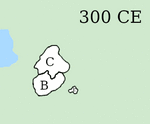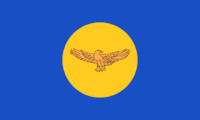Early states of Byasa
The warring states period of Byasanese history (also called the early states period) lasted from the end of prehistory in Byasa until 1006 CE with the formation of the Bhuti dynasty. It was characterized by unstable and unclear political borders, typical of other similar proto-states of the early centuries CE. Early dynasties developed c. the 2nd century CE after the introduction to the concept by merchants from the Han dynasty of Monsilva.
Contents
Overview
The warring states period began in c. 600 BCE and ended in 1006 CE. Proto-states have existed in Byasa since the beginning of the Bronze Age in c. 1000 BCE, but the first actual state didn't develop until c. 500 BCE. The state, named Chamdo A, was a part of the Chamdo proto-culture group of states that existed from 500 BCE until about 100 CE. The states did not have anything to do with Chamdo—the proto-culture was named for the area it was located in. The states of the proto-culture were essentially in a state of perpetual war with each other, and territorial claims were nebulous at best. The proto-culture encompassed a total of six states, stretching from near the northern tip of modern Byasa to north-central Nagstsalachen province.
At the same time, Şovunkyn tribal states similar to those in Uulgadzar began to form. These states were a part of the Rigrongseb proto-culture—once again named after the modern-day area the proto-culture was located in. The five states that were a part of this proto-culture stretched from inside the modern-day Hoydgadzar province of Uulgadzar to the center of the Derixörs province of Byasa. The largest of the five states was Rigrongseb C, which was located generally in the same area as modern-day Rigrongseb. This period with the formation of states is known as the Lower Warring States Period.
Starting in the 2nd century CE, dynasties began to form in the area of the Chamdo proto-culture. Chamdo C is believed to have developed into the first dynasty in Byasanese history, named the Palsang dynasty. Two other dynasties developed as well—the Damdul dynasty from Chamdo A in the 3rd century and the Namdak dynasty from Chamdo F in the 6th century. In the area of the Rigrongseb proto-culture, two formed—the Tutei dynasty from Rigrongseb C in the 5th century and the Telegetu dynasty from Rigrongseb B in the 6th century. By the 7th century, all states on record had consolidated into dynasties. This period with the formation of dynasties is known as the Middle Warring States Period.
In the 8th century, a mysterious collapse occurred where all dynasties disappeared from the historical record. In fact, written records from the era between the 8th century and the formation of the Bhuti dynasty in the 11th century are almost completely non-existent. Several theories exist, however only two have significant archaeological evidence in support of them. The first and most popular is that the dynasties all went to war with each other and all collapsed almost simultaneously after the war ended. The second theory is that an external invading force entered Byasa and destroyed the dynasties. This theory has historically been disregarded, however in recent times the theory has earned credence after archaeological findings revealed there were people in the area of the Chamdo dynasties who did not originate in Byasa or Monsilva and existed around the same period of the collapse. This period is known as the Upper Warring States Period.
The warring states period ended in the 11th century with the formation of the Bhuti dynasty.
Lower period
Northern states
Southern states
The first states of the Rigrongseb proto-culture formed around 200 BCE. Initially, two states formed, named Rigrongseb A and Rigrongseb B. They originated near each other, about in the middle of modern-day Uulbalğsn. These states originally resembled the tribal states that were prevalent during the tribal era of Uulgadzar. However, by 100 CE, relatively large urban areas had appeared and the states moved towards a more standard form for that era. Around the same time, two new states appeared, Rigrongseb C and Rigrongseb D. These states appeared around modern-day Rigrongseb.
In 200 CE, Rigrongseb A and D disappeared. The cause of Rigrongseb A's disappearance is unknown, as archaeological evidence from the region disappears between the state's collapse and the 6th century when the Telegetu dynasty occupied the area. The most prevalent theory is that the state collapsed after a raid from a large nomadic group from the south, however there is very little evidence to support the theory. Rigrongseb D collapsed after a war with Rigrongseb C, and many of Rigrongseb D's settlements were burnt down.
In 300 CE, Rigrongseb E formed southeast of modern Rigrongseb. This was the final state of the Rigrongseb proto-culture to form before the dynastic era of Byasa began. The three remaining states, Rigrongseb B, C, and E remained at peace until the beginning of the Middle period.
Middle period
Northern dynasties
Southern dynasties
The Middle period began in the 5th century when the Tutei dynasty formed from Rigrongseb C. It originated just to the west of modern-day Rigrongseb. The dynasty expanded quickly, likely going as far west as Shiamatso Lake. The formation of this dynasty is generally considered the point where the Şovunkyn culture fully diverged from the general Uulgadzan culture that made up the majority of the original Rigrongseb proto-culture. It is believed the first Uulgadzan script originated in the Tutei dynasty and diffused to Uulgadzar around the 7th century.
The Telegetu dynasty formed in the 6th century from Rigrongseb B. In comparison to the Tutei dynasty, the Telegetu dynasty expanded slowly. By the 7th century, it had absorbed Rigrongseb E. After the formation of the Telegetu dynasty, many small-scale conflicts broke out between the Telegetu dynasty and the Tutei dynasty. Border lands likely traded hands often and were likely in a constant state of war. Around the middle of the 7th century, the death of the emperor in the Tutei dynasty led to a large reduction in land after an attack from the Telegetu dynasty. It is generally believed this was the beginning of the decline of the dynasties in the Rigrongseb hearth area.
By the 8th century, the Telegetu dynasty had also entered decline. It is generally agreed upon that by this point, the two dynasties were no longer bordering each other. This led to a sharp decrease in conflict between the two dynasties. However, around the middle of the 8th century, attacks from small tribes began to wear down the dynasties. Towards the end of the 8th century, attacks from the north began, and the Upper Warring States Period began in the Rigrongseb hearth area.


